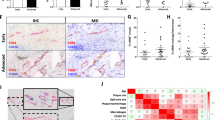Abstract
THE prototype members of the heparin-binding fibroblast growth factor (FGF) family1–6, acidic FGF (FGF-1) and basic FGF (FGF-2), are among the growth factors that act directly on vascular cells to induce endothelial cell growth and angiogenesis. In vivo, the role of the FGF prototypes in vascular pathology has been difficult to determine. We report here the introduction, by direct gene transfer into porcine arteries, of a eukaryotic expression vector encoding a secreted form of FGF-1. This somatic transgenic model defines gene function in the arterial wall in vivo. FGF-1 expression induced intimal thickening in porcine arteries 21 days after gene transfer, in contrast to control arteries transduced with an Escherichia coli β-galactosidase gene. Where there was substantial intimal hyperplasia, neocapillary formation was detected in the expanded intima. These findings suggest that FGF-1 induces intimal hyperplasia in the arterial wall in vivo and, through its ability to stimulate angiogenesis in the neointima, FGF-1 could stimulate neovascularization of atherosclerotic plaques. Potentially, gene transfer of FGF-1 could also be used as a genetic intervention to improve blood flow to ischaemic tissues in selected clinical settings.
Similar content being viewed by others
References
Burgess, W. H. & Maciag, T. A. Rev, Biochem. 58, 575–606 (1989).
Ausprunk, D. H. & Folkman, J. Microvasc. Res. 14, 53–65 (1977).
Abraham, J. A. et al. Science 233, 545–548 (1986).
Gospodarowicz, D., Chen, J., Lui, G. M., Baird, A. & Bohlent, P. Proc. natn. Acad. Sci. U.S.A. 81, 6963–6967 (1984).
Thomas, K. A. et al. Proc. natn. Acad. Sci. U.S.A. 82, 6409–6413 (1985).
Yanagisawa-Miwa, A. et al. Science 257, 1401–1403 (1992).
Nabel, E. G., Plautz, G., Boyce, F. M., Stanley, J. C. & Nabel, G. J. Science 244, 1342–1344 (1989).
Nabel, E. G., Plautz, G. & Nabel, G. J. Science 249, 1285–1288 (1990).
Plautz, G., Nabel, E. G. & Nabel, G. J. Circulation 83, 578–583 (1991).
Lim, C. S. et al. Circulation 83, 2007–2011 (1991).
Chapman, G. D. et al. Circ. Res. 71, 27–33 (1992).
Leclerc, G., Gal, D., Takeshita, S., Nikol, S., Weir, L. & Isner, J. M. J. clin. Invest. 90, 936–944 (1992).
Forough, R. et al. J. biol. Chem. 268, 2960–2968 (1993).
Martin-Zanca, D., Oskam, R., Mitra, G., Copeland, T. & Barbacid, M. Molec. cell. Biol. 9, 24–33 (1989).
Nabel, E. G., Plautz, G. & Nabel, G. J. Proc. natn. Acad. Sci U.S.A. 89, 5157–5161 (1992).
Nabel, E. G. et al. J. clin. Invest 91, 1822–1829 (1993).
Gajdusek, C. M. & Carbon, S. J. Cell Physiol. 139, 570–579 (1989).
McNeil, P. L., Muthukrishnan, L., Warder, E. & D'Amore, P. A. J. Cell Biol. 109, 811–822 (1989).
Viodavsky, I., Folkman, J., Sullivan, R., Friedman, R. & Ishai-Michaeli, R. Proc. natn. Acad. Sci. U.S.A. 84, 2292–2296 (1987).
Jackson, A. et al. Proc. natn. Acad. Sci. U.S.A. 99, 10691–10695 (1992).
Lindner, V., Lappi, D. A., Baird, A., Majack, R. A. & Reidy, M. A. Circ. Res. 68, 106–113 (1991).
Jawien, A., Bowen-Pope, D. F., Lindner, V., Schwartz, S. M. & Clowes, A. J. clin. Invest. 89, 507–511 (1992).
Barger, A. C., Beeuwkes, R. III, Lainey, L. L. & Silverman, K. J. N. Engl. J. Med. 310, 175–177 (1984).
Mosmann, T. J. immun. Meth. 65, 55–63 (1983).
Ellis, S. A., Taylor, C. & McMichael, A. Hum. Immun. 5, 49–59 (1982).
Clowes, A. W., Clowes, M. M. & Reidy, M. A. Lab Invest. 54, 295–303 (1986).
Author information
Authors and Affiliations
Rights and permissions
About this article
Cite this article
Nabel, E., Yang, Zy., Plautz, G. et al. Recombinant fibroblast growth factor-1 promotes intimal hyperplasia and angiogenesis in arteries in vivo. Nature 362, 844–846 (1993). https://doi.org/10.1038/362844a0
Received:
Accepted:
Issue Date:
DOI: https://doi.org/10.1038/362844a0
- Springer Nature Limited
This article is cited by
-
FGF1ΔHBS prevents diabetic cardiomyopathy by maintaining mitochondrial homeostasis and reducing oxidative stress via AMPK/Nur77 suppression
Signal Transduction and Targeted Therapy (2021)
-
Matrix Production in Chondrocytes Transfected with Sex Determining Region Y-Box 9 and Telomerase Reverse Transcriptase Genes: An In Vitro Evaluation from Monolayer Culture to Three-Dimensional Culture
Tissue Engineering and Regenerative Medicine (2019)
-
RETRACTED ARTICLE: Fibroblast growth factor receptor 4 polymorphisms and the prognosis of non-Hodgkin lymphoma
Molecular Biology Reports (2014)
-
Fibroblast growth factor receptor 4 polymorphism is associated with increased risk and poor prognosis of non-Hodgkin’s lymphoma
Tumor Biology (2014)
-
Therapeutic angiogenesis for myocardial ischemia revisited: basic biological concepts and focus on latest clinical trials
Angiogenesis (2012)





